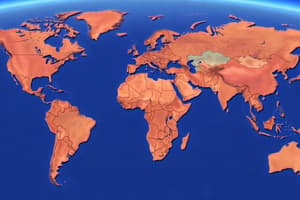Podcast
Questions and Answers
What is the primary distinction between immigration and emigration?
What is the primary distinction between immigration and emigration?
- Immigration involves moving out of a country.
- Immigration is also called in-migration. (correct)
- Emigration is associated only with refugees.
- Emigration refers to moving into a new country.
Which of the following is a commonly recognized push factor for migration?
Which of the following is a commonly recognized push factor for migration?
- Job opportunities
- Political fear or persecution (correct)
- Enjoyment
- Better medical care
What term describes the migration of highly skilled specialists from one country to another?
What term describes the migration of highly skilled specialists from one country to another?
- Brain-drain (correct)
- Internal migration
- Seasonal migration
- Forced migration
Which historical event led to significant migrations due to refugees or displaced persons?
Which historical event led to significant migrations due to refugees or displaced persons?
Which of the following is considered an internal migration?
Which of the following is considered an internal migration?
What commonly drives interstate migrations in Asia during the early 20th century?
What commonly drives interstate migrations in Asia during the early 20th century?
Which of these factors would generally not be considered a pull factor?
Which of these factors would generally not be considered a pull factor?
What was a significant cause of mass migrations after the decline of the primitive communal system?
What was a significant cause of mass migrations after the decline of the primitive communal system?
Which of the following best describes the nature of nomadic movements?
Which of the following best describes the nature of nomadic movements?
How did the exchange of population occur between India and Pakistan?
How did the exchange of population occur between India and Pakistan?
Flashcards are hidden until you start studying
Study Notes
Introduction to Migration
- Migration is the movement of people intending to settle permanently in a new location.
- It has historically influenced settlement patterns, economic development, cultural exchanges, and demographic changes.
- Migration can occur over long distances between countries or as internal movements within a country; internal migration is currently the dominant global form.
- Nomadic movements are not classified as migration due to their lack of intent to settle and their seasonal nature.
- Early migrations included spontaneous resettlements of ancient tribes, leading to peaceful territorial development.
- Mass migrations arose with population growth and societal changes, particularly after the decline of communal living.
- Major intercontinental migrations surged post-16th century during European geographic discoveries, particularly to America.
- The 20th century saw the rise of interstate migrations for labor, especially in Asian regions like China and India.
- The "brain drain" phenomenon began in the 1930s, attracting skilled individuals to countries like the USA.
- Significant migrations occurred during and after World War II, including the refugee crisis and the population exchange between India and Pakistan.
Push Factors of Migration
- Factors that drive people away from their current location include:
- Lack of job opportunities and economic prospects.
- Inadequate living conditions and housing.
- Environmental issues such as desertification and natural disasters.
- Political instability, fear of persecution, and war.
- Health-related challenges like poor medical care.
- Social issues such as discrimination and forced labor.
Pull Factors of Migration
- Positive attributes attracting individuals to new locations include:
- Availability of job opportunities and better economic conditions.
- Improved living and housing conditions.
- Greater political and religious freedoms.
- Access to education and healthcare.
- Desirable climates and enhanced security.
- Personal connections, such as family links.
Types of Migration
- Migration is categorized into two main types:
- Immigration: Movement of people into a country or region from their place of residence, often referred to as "in-migration."
- Emigration: Movement of people out of a country or region from their place of residence, referred to as "out-migration."
Studying That Suits You
Use AI to generate personalized quizzes and flashcards to suit your learning preferences.




